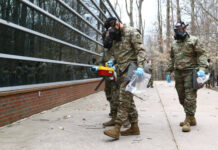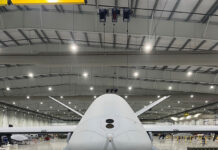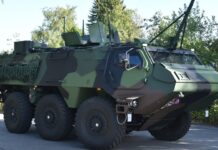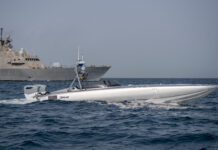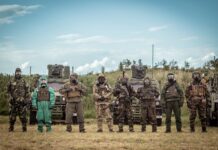In response to an increasingly challenging international security environment, Denmark has decided to accelerate the modernisation of its armed forces. Efforts are being undertaken both in the short and long term, to strengthen Denmark’s deterrence capabilities and enhance its contribution to NATO.
![Danish soldiers training in Kangerlussuaq, Greenland, during June 2025. [Forsvaret/Rebekka Gimm]](https://euro-sd.com/wp-content/uploads/2025/07/Danish-Soldiers-in-Greenland-Kopie-1024x621.jpg)
The agreement outlines a framework for cooperation on boosting military capabilities and envisions several partial agreements. The first of these was concluded in January 2024, with a second following in April. The latter expanded the financial framework of the Defence Agreement for the years 2024–2028 by an additional DKK 35.2 billion, bringing the total to approximately DKK 190 billion for the entire agreement period.
To further accelerate modernisation, the government introduced the Acceleration Fund (Accelerationsfonden) in early 2025. This mechanism also includes provisions for military support to Ukraine. In 2025 and 2026 alone, Copenhagen plans to spend a total of DKK 50 billion. By 2033, total defence expenditure under this initiative are expected to reach DKK 120 billion, pushing Denmark’s defence spending above 3% of GDP.
“We must move more quickly to build the Armed Forces’ combat power if we are to adapt to the changed security policy landscape. The Acceleration Fund ensures that the Armed Forces have a more flexible framework to strengthen this combat power at a faster pace,” said Poulsen, who added in April 2025: “The threats we face at sea today are different, and far more serious, than just a few years ago. It is particularly a threatening Russia that we must respond to, while at the same time, technological developments are advancing at a tremendous pace.”
Having said that, further increases or budgetary changes would seem necessary given that at NATO’s June 2025 Summit in The Hague, Denmark, along with other allies, committed to spending 5% of GDP on defence by 2035. This 5% figure is split into 3.5% aimed at ‘core’ defence capabilities, and 1.5% aimed at looser defence, security, and resilience-related measures which could provide benefits in wartime, such as civil preparedness, improvements to port, rail, bridging infrastructure, or investments in industrial capacity.
Land forces
Denmark plans to establish a heavy brigade by restructuring its 1st Brigade based in Holstebro. It is one of the country’s two operational brigades and a key contributor to NATO forces. Under the framework of the Acceleration Fund, development of the heavy brigade is scheduled for the 2025-2033 period. The brigade will consist of two infantry companies, a reconnaissance platoon, a tactical drone section, a mechanised engineer company, and new engineering support equipment. To enhance its operational capabilities, Denmark plans to invest in main battle tanks (MBTs) and infantry fighting vehicles (IFVs).
![To address capability gaps created by the transfer of military vehicles to Ukraine, Denmark will acquire additional 115 CV9035 Mk IIIC infantry fighting vehicles for EUR 1.35 billion. [Forsvaret/Magnus]](https://euro-sd.com/wp-content/uploads/2025/07/CV90-Kopie-1024x683.jpg)
In the domain of unmanned systems, March 2025 saw the opening of a drone centre in Odense, a DKK 725 million project aimed at training Danish personnel in drone operations. These systems are expected to be integrated in large numbers in the coming years.
To address capability gaps created by the transfer of military vehicles to Ukraine, Denmark will acquire 115 CV9035 Mk IIIC IFVs for EUR 1.35 billion. Deliveries, managed by BAE Systems Hägglunds, are scheduled for 2026-2029. Denmark initially purchased 45 CV9035s in 2005 for EUR 188 million. Additionally, in cooperation with Sweden, Denmark will co-finance 40 more CV90s for delivery to Ukraine.
Denmark has already completed the modernisation of its Leopard 2A5 MBT fleet. The final upgraded tanks, converted to the 2A7 standard, were delivered by German manufacturer Krauss-Maffei Wegmann (KMW) in September 2023. These tanks are assigned to the Jutland Dragoon Regiment’s sole armoured battalion, stationed in Holstebro.
The upgrade programme included installation of a modern battlefield management system, replacement of the L44 smoothbore gun with the longer and higher-pressure L55A1 (allowing use of next-generation ammunition), and modernisation of the fire control system (FCS). Observation and targeting systems, internal and external communications, climate control, and chemical, biological, radiological, nuclear (CBRN) protection systems were also upgraded. Improvements were made to both the armour and the drivetrain. These upgraded tanks are expected to remain in active service for at least two more decades.
![Denmark has already completed the modernization of its Leopard 2A5 main battle tank fleet. The final upgraded tank, converted to the 2A7 standard, was delivered by KMW in September 2023. [Forsvaret]](https://euro-sd.com/wp-content/uploads/2025/07/Leopard-2-Kopie-1024x683.jpg)
Previously, Denmark operated Leopard 1A5DK tanks, which were decommissioned in 2005 and sold to Germany in 2010. In 2023, Denmark reacquired some of these vehicles – not for domestic use, but to jointly transfer them to Ukraine, along with Germany and The Netherlands. However, many of the tanks were found to be unusable due to their poor technical condition.
In April 2025, Denmark announced its joining of the Common Armoured Vehicle System (CAVS) programme, alongside Finland, Latvia, Sweden, and Germany. Under this framework, Denmark will use funds from the Acceleration Fund to purchase 130 Patria 6×6 armoured personnel carriers (APCs) for DKK 1.9 billion. The first deliveries are expected to begin later in 2025. These vehicles will serve both the light infantry battalion and a heavy brigade. Denmark will procure several variants, including infantry carriers, engineer vehicles, command and communications vehicles, medical evacuation units, and electronic warfare platforms.
Aviation and air defence
Denmark ordered a total of 27 F-35A fighters ordered to replace its ageing F-16 fleet. Presently, the Royal Danish Air Force (Flyvevåbnet) has 15 F-35s in active service, while an additional six remain in the United States for training and education purposes. The final six aircraft are expected to be delivered by the end of 2026. Denmark has not ruled out the possibility of acquiring an additional batch of F-35s, although current diplomatic tensions with the US over Greenland may complicate further purchases.
Notably, the last F-16 is scheduled for retirement by the end of 2025, two years ahead of the original plan. As part of its contribution to Ukraine, Denmark has decided to transfer 19 of its 43 F-16s, while the remaining 24 have been sold to Argentina. So far, 12 F-16s have been delivered to Ukraine. The F-35s are already being used operationally and in April 2025, a Danish jet intercepted a Russian Il-20 reconnaissance aircraft near Bornholm.
![Denmark continues the rollout of its F-35A fighter aircraft, with a total of 27 ordered to replace its ageing F-16 fleet. [NATO AIRCOM]](https://euro-sd.com/wp-content/uploads/2025/07/F-35As-Kopie-1024x683.jpg)
In March 2025, Denmark inaugurated the Air Defence Wing at Skalstrup Air Base to strengthen its ground-based air defence. Once operational, the Wing will fall under the command of the Royal Danish Air Force. Just weeks later, Denmark announced the procurement of between 250 and 1,000 MISTRAL 3 surface-to-air missiles, capable of intercepting targets at distances of up to 8 km and altitudes up to 6 km. These very short range air defence (VSHORAD) systems represent a top modernisation priority for Danish defence planners.
Denmark also plans to develop a medium-range air defence capability. Two systems have been shortlisted: the American Patriot system and the European SAMP/T NG (surface-to-air missile platform/terrain), proposed by the EUROSAM consortium (MBDA and Thales). For short-range solutions, four systems are under consideration: the French VL MICA (MBDA France), the German IRIS-T SLM (Diehl Defense), the Norwegian-US NASAMS (Kongsberg), and the US ‘Enduring Shield’ (Dynetics) system. Contracts are expected to be signed by the end of 2025, with operational deployment planned for 2028. Copenhagen is also exploring interim solutions, including leasing options.
In a separate development, in September 2024, Denmark signed an agreement with Rheinmetall Air Defence for the acquisition of 16 Skyranger 30 turrets and accompanying AHEAD family airburst munitions. Four prototypes are scheduled for delivery by the end of 2026, followed by three production batches, each consisting of four turrets, in 2027 and 2028. These systems will be integrated into Piranha V 8×8 armoured vehicles and paired with MISTRAL 3 missiles (Denmark originally procured 309 Piranha V vehicles in 2015, delivered in six configurations: infantry fighting, command, ambulance, engineer, mortar, and repair variants).
Navy
Denmark is moving forward with a comprehensive modernisation of its Royal Danish Navy (Søværnet). In April 2025, Copenhagen unveiled a long-anticipated plan as part of its broader 2024-2033 defence modernisation framework. The strategy outlines both short-term and long-term upgrades to strengthen Denmark’s maritime defence posture.
The first phase of the programme, already funded with EUR 480 million, focuses on enhancing surveillance capabilities of critical undersea infrastructure (CUI). Key investments include a new sea surveillance vessel capable of deploying, operating, and recovering undersea drones, remotely operated vehicles (ROVs), and mobile sonar systems. Denmark also plans to procure autonomous and remote-controlled vessels for surface and subsurface monitoring. In March 2025, Copenhagen announced the acquisition of several hundred naval mines, expected to be delivered between 2027 and 2029, reinforcing Denmark’s deterrence and area denial capabilities.
![Danish frigate Niels Juel is seen together with the French minesweeper Croix du Sud during NATO’s during the surveillance of CUI in the Baltic Sea. [Forsvaret/Theis Nielsen]](https://euro-sd.com/wp-content/uploads/2025/07/Niels-Juel-and-Croix-du-Sud-Kopie-1024x596.jpg)
Over the long term, Denmark plans to acquire new air defence frigates. As a result, the three Iver Huitfeld class frigates, which have been in service since 2011, are expected to remain operational for at least another decade. The two older Absalon class frigates, commissioned between 2004 and 2005, will also stay in service and are slated to receive new towed sonar systems to enhance their anti-submarine warfare (ASW) capabilities.
Future decisions will also include the potential procurement of additional Arctic vessels to enhance operational capacity in the Arctic and North Atlantic. These acquisitions are being developed in consultation with the Faroe Islands and Greenland governments and will form part of a future partial defence agreement. Denmark is now procuring three ships as a replacement for its ageing Thetis class patrol frigates, four of which remain operational and were commissioned between 1991 and 1992. The new multirole patrol vessels, designed and built by the Danske Flådeskibe K/S consortium (comprising Terma, Odense Maritime Technology, and PensionDanmark), are expected to significantly enhance Denmark’s presence in Arctic waters. The first unit is scheduled for delivery by 2029.
These procurements represent a strategic shift toward strengthening Denmark’s capabilities in the High North, widely seen as a response to deteriorating international security conditions in the Arctic region and GIUK Gap (Greenland-Iceland-United Kingdom). Russia’s full-scale invasion of Ukraine has heightened European concerns over the possibility of sabotage or hybrid attacks, particularly in the North Atlantic. The region remains an area of heightened strategic importance, not least because of the operations of the Russian Northern Fleet, headquartered in Severomorsk, Murmansk Oblast. Additionally, the increasing presence of Chinese warships in the Northern Atlantic has drawn the attention of Danish and NATO defence planners alike.
For now, there are no official plans for Denmark to acquire submarines, which the country phased out in 2004. The decision to abandon submarine capabilities was part of the broader ‘peace dividend’ following the end of the Cold War, based on the widespread belief that war in Europe was unlikely to return. In 2023, there were indications that decision-makers in Copenhagen had been considering whether to invest in a new generation of submarines or instead rely on close cooperation with allies to maintain undersea capabilities. However, any attempt to rebuild Denmark’s submarine force would be a long-term and costly endeavour, requiring significant financial and industrial resources.
In May 2025, Denmark announced the acquisition of ESSM Block 2 (Evolved Sea Sparrow Missiles) for its Iver Huitfeld– and Absalon class frigates, with the Accelerationsfonden allocating DKK 880 million for the purchase. The announcement follows closely on the heels of a controversy surrounding munition deficiencies aboard the HDMS Iver Huitfeldt, which had been deployed to the Red Sea as part of operations against Houthi forces. The incident, widely covered in Danish media in April 2025, led to the dismissal of Chief of Defence Flemming Lentfer, underscoring the gravity of the issue.
![F341 Absalon launches a Harpoon missile. Two frigates of this class, commissioned between 2004 and 2005, will also stay in service and are slated to receive new towed sonar systems to enhance their anti-submarine warfare (ASW) capabilities. [Forsvaret/Henning Jespersen-Skree]](https://euro-sd.com/wp-content/uploads/2025/07/F341-Absalon-firing-Harpoon-Kopie-1024x681.jpg)
In a related move, Denmark signed a deal with Kongsberg in March 2025 worth NOK 2.1 billion for the procurement of Naval Strike Missiles (NSMs) to equip its Iver Huitfeld class frigates. These modern systems will replace the ageing Harpoon missiles. With this acquisition, Denmark becomes the 14th user of the NSM system, thereby signalling a significant upgrade in its maritime strike capabilities.
Robert Czulda



![Danish soldiers training in Kangerlussuaq, Greenland, during June 2025. [Forsvaret/Rebekka Gimm]](https://euro-sd.com/wp-content/uploads/2025/07/Danish-Soldiers-in-Greenland-Kopie.jpg)

![Nanotechnology: Threats and prospects in the CBRN sector US Airmen from the 426th Air Base Squadron conducting chemical, biological, radiological and nuclear (CBRN) training at KNM Harald Haarfagre, Stavanger, Norway, on 20 May 2025. [USAF/A1C Adam Enbal]](https://euro-sd.com/wp-content/uploads/2025/09/CBRN-Norway_USAFA1C-Adam-Enbal-Kopie-218x150.jpg)
![Hybrid navies: Integrating uncrewed capability into carrier strike The US Navy (USN) carrier USS John C Stennis (left), the French Navy carrier FS Charles de Gaulle, and elements of their strike groups are pictured sailing together in US Fifth Fleet’s area of operations. The US, French, and UK navies are all developing ‘hybrid’ crewed/uncrewed mixes for their carrier airwing capability. [US Navy]](https://euro-sd.com/wp-content/uploads/2025/09/2-HST-CdG-USN-Kopie-218x150.jpg)

